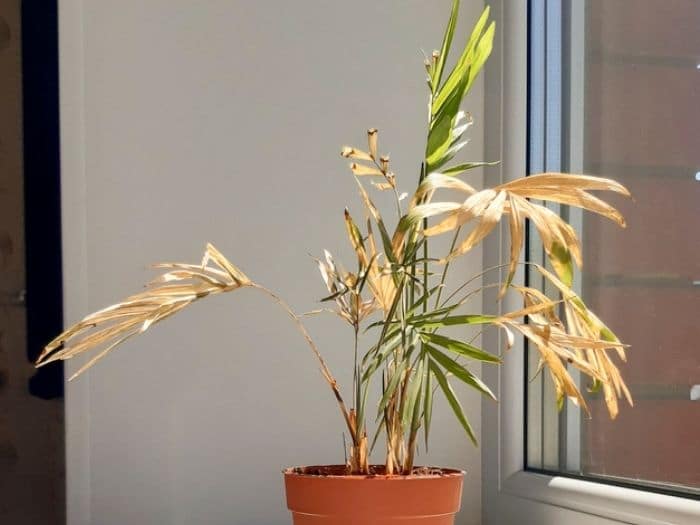Foxtail Palm Problems and Diseases (With Solutions)
Foxtail palm is an easy and fast-growing palm tree that produces clusters of colorful red fruits and big tufted fronds with a lush, full, feathery look. While this type of palm tree can appear very easy to care for and can withstand drenching rainy seasons, it’s still susceptible to a variety of diseases, and pests.
Understanding the most common foxtail palm problems and diseases can help you properly diagnose and fix the issues.
Common Foxtail Palm Problems
1. Leaf discoloration
The discoloration may include brown leaf tips and yellowish fronds that last for more than three days. The browning of leaf tips is a result of frizzletop, a condition caused by manganese deficiency.
As the deficiency progresses, the tips of existing leaves of foxtail palm wither and die while the new leaves emerge with a streaking or a yellowish discoloration.
On the other hand, the yellowing of fonds is a result of potassium or magnesium deficiency.
Usually, mineral deficiency occurs when foxtail palms trees are planted in soils with a pH above 7.0. So, the first thing you need to do to remedy this problem is to correct high pH. You can do this by enriching the soils with sulfur-containing feeds. If the soils have low pH, add lime.
Another way to treat manganese deficiency is to apply manganese sulfate foliar spray to the affected palm trees at least once every two months. Sometimes marketed as palm fertilizer, manganese sulfate foliar spray will give your foxtail palm the much-needed manganese boost. Mix the fertilizer at a ratio of 1/2 ounce per gallon.
2. Insects and pests
Foxtail palm trees are also prone to insects and pests. For instance, beetles such as coconut rhinoceros beetle make holes in the trunks and eat the inside of foxtails palm trees.
Another pest you will encounter is the red palm weevil, which lays eggs in the holes made by rhinoceros beetles. When it comes to insects, you will have to deal with palm aphids, palm leaf skeletonizers, spider mites, mealybugs, and scale insects.
You will not be able to reverse the damage done but you can easily get rid of insects and pests from your plant. One of the best ways of controlling insects and pests is the use of insecticides and pesticides such as Chaindrite Crack and Crevice aerosol, Chaindrite Stedfast and Sparkle G.
Always keep in mind that preventive practices are always more effective than trying to stop an active infestation.
3. Drooping fronds
Another foxtail palm problem you will encounter is the drooping of fronds extending for more than three days. If the droopy fronds are accompanied by yellow or brown discoloration, it would be an indication that your foxtail palm tree isn’t getting enough water.
Droopy fronds accompanied by mild to severe wilting or a general plant decline might be a sign of Ganoderma root and butt rot.
Don’t remove the remove those drooping fronds because the chlorophyll in the leaves is still facilitating photosynthesis. If the drooping fronds are a result of underwatering, you need to make sure your plant is watered regularly. If the drooping leaves are a result of Ganoderma root and butt rot, unfortunately, there are no chemical controls for preventing the disease. You will need to remove as much of the damaged root system as possible.
4. Crown rot
Crown rot is due to poor cultural practices including overwatering and using poorly drained soil mix. Symptoms of crown rot in foxtail palm include yellowing or browning of fronds and some parts of the stems. Inground, the root system may turn mushy and too soft. Above ground, the plants may start experiencing mild to severe wilting and slow growth.
To fix this problem, try to cut away affected roots bark. Stop watering the plant for some time and remove wet soils from the base of your foxtail palm down to the main roots. Removing the wet soils from this area will allow the crown to dry out.
Another effective way of controlling crown rot is the use of fungicide. However, fungicides may not be fully effective if the disease has completely taken hold of the plant.
5. Fronds not opening
Another problem common with foxtail palm is fronds failing to open. Some of the reasons for fronds not opening include missing soil nutrients, overwatering or underwatering, and frozen palm spears. For instance, boron deficiency may cause deformed spear leaf growth.
Well-timed fertilization can help you solve the issue of nutrient deficiency. Also, carry out proper watering practices such as watering your foxtail palm based on the weather. To fix frozen palm spears, you will need to protect your plant from the cold.
6. Fungal diseases
Some of the fungal diseases that attack foxtail palm include leaf spots and leaf blights, Ganoderma butt rots, diamond scale, fusarium wilt, false smut, and bud rot. You will tell your foxtail palm tree is diseased based on the type of disease, nature, and impact.
Most of these diseases can be treated using recommended fungicides. Pruning away the most infected fronds is also another sure way of preventing fungal diseases from spreading. Preventive measures such as proper watering and sanitizing pruning tools can also protect your palms from fungal attacks.
7. Sooty molds
The main cause of sooty molds is the excess sugar secreted by insects. The molds appear as black or gray mold on the fronds. They do not affect the entire tree but it reduces the tree’s aesthetic appearance.
One of the effective ways of eliminating molds from your plant is through spraying. This method of mold removal is only effective in smaller palms.
Signs of An Unhealthy Foxtail Palm Tree
- Yellow or brown fronds that fall off before drying
- The tips of the leaves start turning brown and eventually dies.
- Stunted growth or decline in growth
- The palm fronds experience mild to severe wilting
- Flopping over of crown due to internal trunk rot.
- Tips of your palm usually start to turn darker or even brown.
- Palm leaves turn brown, orange, or yellow spots that spread practically whole sharp edge
- Palm leaves with green spotting, broken closures, and slender green veins.
- Older fronds withering or roping
- Spotted or frizzled fronds
- Lack of new crown growth.
- Young fronds and buds start showing black lesions
- A slimy rot on the buds of the affected palm trees.






Deteriorating foxtail palm in central Florida. Drooping crown and fronds. 4 others are doing great. Can’t find anyone that really has any idea what the problem is based on pictures I’ve posted.
My foxtail palm froze and now it doesn’t produce a spike instead the fraud starts to open as it emerges and is slow to grow, should I replace it?
Mine too